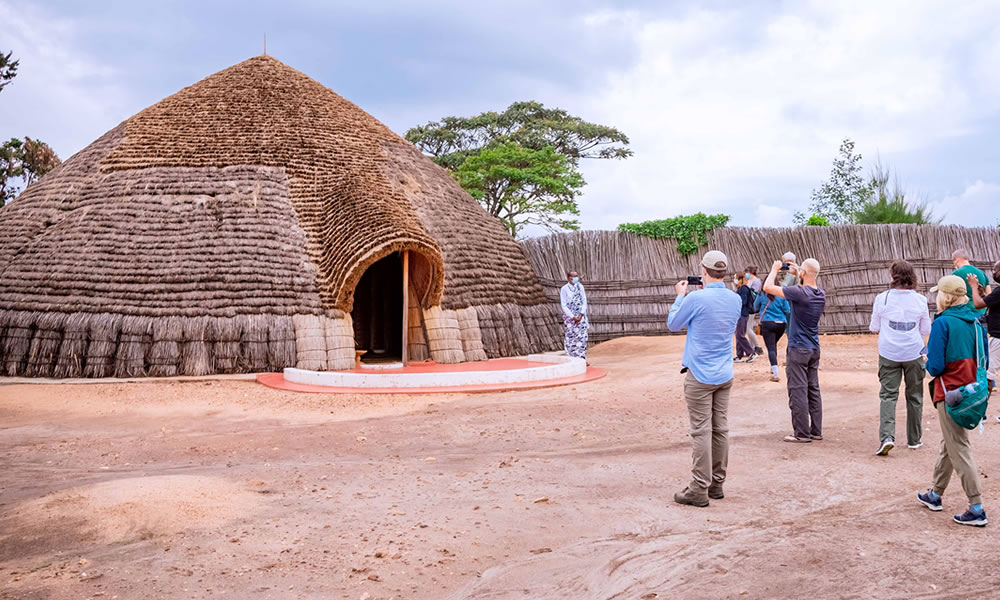Rwanda’s history is not just written in books: it’s alive, vibrant, and thriving in its palaces, traditions, and museums. One of the most fascinating places where you can truly feel this history is the Kings Palace Museum, located in the lush hills of Nyanza District. This isn’t just a museum, It’s a journey through time, offering an intimate look at the life of Rwanda’s kings and their cultural heritage. Whether you’re a history buff, a curious traveler, or someone just eager to explore, the Kings Palace Museum promises an unforgettable adventure into Rwanda’s royal past.

A Step Back in Time: The History of the King’s Palace
Imagine walking through the same halls where kings once ruled. The Kings Palace Museum was home to King Yuhi V Musinga in the early 20th century, back when Rwanda was a unified kingdom under a central monarchy. The palace was the political and cultural heart of the nation, a place where decisions were made that shaped Rwanda’s future. Today, the museum stands as a reminder of the strength and unity the monarchy brought to the country.
Walking through this palace feels like stepping into a different world; one where royal traditions governed the land, and kings were not only leaders but also spiritual and cultural symbols. The museum preserves this legacy, allowing visitors to connect with Rwanda’s deep-rooted history.
Features of the King’s Palace Museum
What makes the King’s Palace Museum truly special is its ability to bring history to life through its stunning features.
Traditional Palace Architecture
At the heart of the museum is the replica of a traditional 19th-century palace, which has been carefully reconstructed to show what royal life was like in pre-colonial Rwanda. This thatched palace is made entirely from local materials, showcasing the brilliant craftsmanship of Rwandan builders. Walking through the palace, you can almost hear the whispers of the past: stories of kings, queens, and courtiers who once filled these halls.
The Majestic Inyambo Cows
Step outside the palace, and you’ll encounter something truly unique, Inyambo, the royal long-horned cows. These majestic animals, with their large, elegant horns, were once paraded during royal ceremonies to symbolize power and prestige. The bond between the cows and their caretakers is heartwarming herders sing traditional songs to soothe the cows, creating a peaceful, almost sacred atmosphere. It’s a beautiful, living connection to Rwanda’s royal traditions.
Exploring the King’s Palace Museum: Past Meets Present
The King’s Palace Museum offers more than just a stroll through history. It’s a multi-sensory experience that allows you to see, touch, and feel Rwanda’s royal heritage.
Royal Regalia and Artifacts
Inside the museum, you’ll find a collection of royal regalia and artifacts, including the tools, clothes, and personal items used by Rwanda’s kings. Each item tells a storywhether it’s the royal spears used in ceremonies or the intricately designed crowns worn by the monarchs. These artifacts provide an intimate glimpse into the lives of the kings and their role in shaping Rwanda’s history.
The Replica 19th-Century Palace
This palace isn’t just for show, it’s a faithful recreation of the kind of home that housed Rwanda’s royals before the influence of colonization. Made entirely from local materials like grass, wood, and clay, it’s an impressive display of traditional Rwandan architecture. Every corner of this palace reflects the importance of community and tradition, from the spacious rooms where the king entertained guests to the more private quarters reserved for the royal family.
The Modern Palace Built by King Mutara III Rudahigwa
In contrast to the traditional palace stands the modern palace, built in 1932 by King Mutara III Rudahigwa. This building represents Rwanda’s transition into a more modern era, blending traditional Rwandan elements with European architecture. Walking through this palace gives you a sense of how Rwanda navigated the complex changes brought by colonization, while still maintaining its cultural identity.
The Cultural Significance of the King’s Palace Museum
The Kings Palace Museum isn’t just about history, it’s about understanding Rwandan culture and its deep ties to the monarchy.
Royal Ceremonies and Traditions
The museum plays an essential role in preserving the royal ceremonies and traditions that were integral to Rwandan society. From traditional dances performed during royal events to the storytelling sessions where the king’s exploits were passed down through generations, the museum keeps these customs alive for both locals and visitors to experience. It’s not just a place to see artifacts, it’s a place to feel the pulse of Rwandan culture.
FAQs
When is the best time to visit the King’s Palace Museum?
The museum is open year-round, but the best time to visit is during Rwanda’s dry season, which runs from June to September. The pleasant weather allows for a more comfortable exploration of the outdoor areas, especially when visiting the Inyambo cows.
How do I get to the King’s Palace Museum?
The museum is located in Nyanza District, roughly 88 kilometers from Kigali, Rwanda’s capital. It’s easily accessible by road, and you can take either a private car or public transport. Many tour operators also offer guided trips to the museum, making it a convenient stop for anyone exploring Rwanda’s cultural sites.
Conclusion: Dive Into Rwanda’s Royal Legacy
The Kings Palace Museum offers an unforgettable journey into Rwanda’s royal past. Whether it’s the beautifully reconstructed palaces, the magnificent Inyambo cows, or the rich cultural traditions that continue to be celebrated, the museum provides a deeper understanding of Rwanda’s history and identity. It’s a place where history isn’t just displayed, it’s brought to life.
So, why wait? Plan your visit to the Kings Palace Museum today and step into a world of majesty, culture, and history. Experience Rwanda’s royal legacy for yourself, you won’t be disappointed!